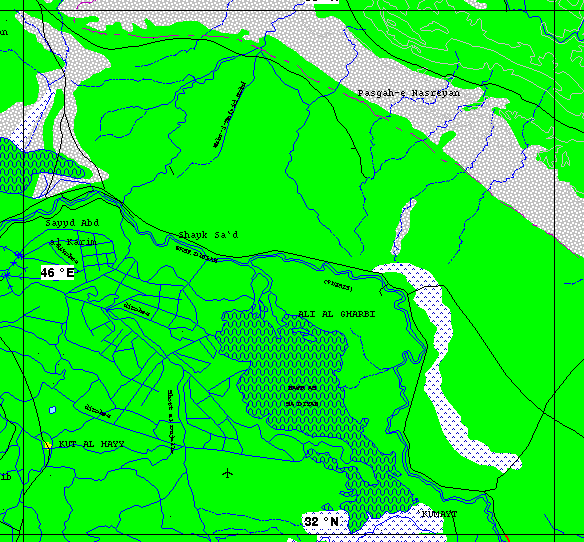





The facility at Zaafarniyah was under the control of the Iraqi Ministry of Industry and Military Production.
The Iraqi nuclear weapons effort, which was directed from the PC-3 headquarters received raw uranium for processing from mines at Ukashat. Seven facilities were promiment in the calutron enrichment program. Four of these facilities, al-Jesira, al-Atheer and al-Rabbiyah and al-Dijjla at Zafaraniyah, had not been identified by American intelligence as being associated with the nuclear weapons program and consequently escaped any significant damage from coalition airstrikes during the Gulf War. The three other facilities -- Tuwaitha, Tarmiya, and al-Fajar -- were previoiusly identified by American intelligence as being associated with the nuclear weapons program and suffered extensive damage during the War. Another program for the production of uranium under the Petrochemical-3 project used gas centrifuge enrichment, with two facilities at Al Furat and Rashidiya, and a third under construction at Taji.
In addition to attempting to build high-speed centrifuges to enrich uranium, Iraq had developed electromagnetic isotope separation (EMIS), also known as the calutron method. Facilities involved with the nuclear weapons program include locations known as al-Rabbiyah [al-Rabee-ah] and al-Dijjla. Both are located in or near Zafaraniyah, a suburb south of Baghdad near al-Tur, north of Rashid Camp.Neither site was damaged by bombing during the Gulf War. The complex was rendered inoperative by UNSCOM in the course of four inspections following the Gulf War.
On 17 January 1993 the US Navy conducted a Tomahawk Land Attack Missile (TLAM) strike against the Zaafaraniyah nuclear fabrication facility because of Iraq's refusal to comply with nuclear inspection requirements. Four surface vessels fired a total of 44 TLAM cruise missiles against the facility, rendering it unusable. This facility was selected because of its role in Iraq's electromagnetic isotope separation (EMIS) program. The Coalition attack was designed to help achieve the goals of UN Security Council Resolutions 687, 707, and 715 requiring Iraq to accept the inspection and elimination of its weapons of mass destruction and ballistic missiles. Zaafariniyah had been inspected a number of times, and some equipment used for the production of EMIS components for Iraq's nuclear weapons program was removed. The facility nonetheless contained precision machine tools used to fabricate items for military and civilian customers and that could again be used to support Iraq's nuclear weapons program. Prior to the Coalition forces attack on the Zafaraniyah plant January 1993, orders were issued to move most of the equipment and all sensitive material from the al-Nida Establishment building. Al-Nida, which is part of the Zafaraniyah compound, specialized in research and production. One cruise missile went or was shot off course and hit the Al Rashid hotel in Baghdad, killing at least three civilians. The errant impact of a Tomahawk cruise missile during the attack on the Zaafaraniyah industrial complex raised concerns around the world over the deaths of civilians.
UNSCOM #48, a missile team, and UNSCOM #49/IAEA #17, a nuclear team, arrived in Iraq just a week after the cruise missile attack on the Al Zaafaraniyah nuclear-related facility. The nuclear team inspected the Al Zaafaraniyah site, confirmed that only buildings with technical functions had been hit, and verified the destruction of many highly sensitive machine tools. A total of 5 or 6 computerized machine tools were located at Al-Rabee-ah that probably were not moved in preparation for IAEA inspections following the Gulf War. Among facilities destroyed in the 1998 year-end Desert Fox raids were a major missile-repair and development facility at Taji, a machine tool plant at Zaafaraniyah and a site at Shahiyat where the Iraqis tested engines for rockets and missiles.


